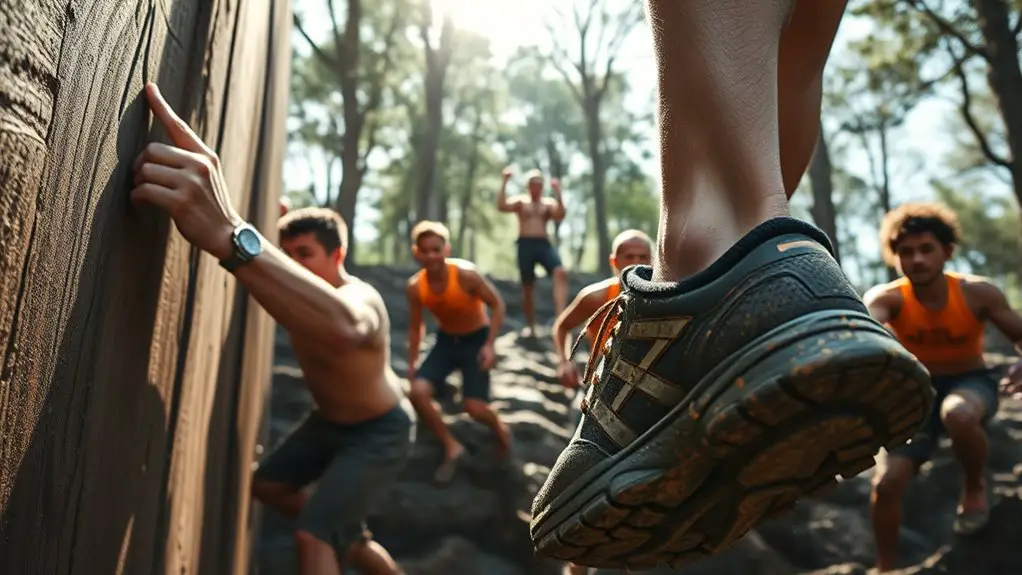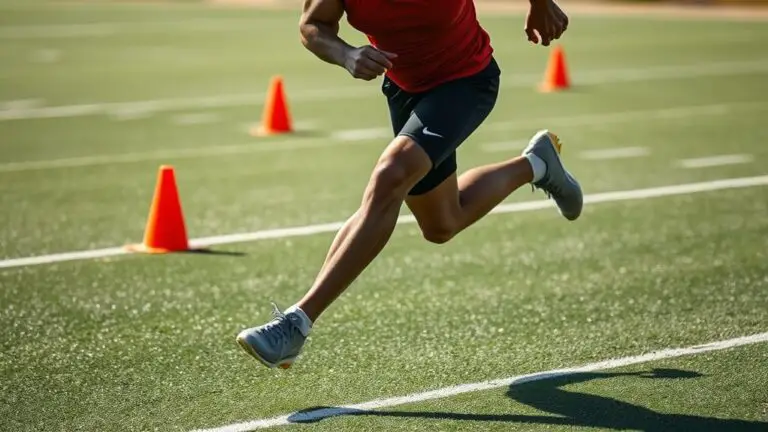How to Train for Obstacle Course Races Like Spartan Race

To train for obstacle course races like Spartan Race, focus on building strength, agility, and endurance. Incorporate strength training exercises like squats and pull-ups, alongside agility drills using ladders. Don’t forget to build your cardiovascular base with interval sprints and long-distance runs. Practice techniques for each key obstacle and enhance your flexibility through dynamic stretching and foam rolling. Proper nutrition and recovery are essential too. Keep going, and you’ll discover more strategies to boost your performance!
Understanding the Demands of Obstacle Course Racing

When you commence on the journey of preparing for an obstacle course race, it is essential to understand the unique demands these events place on your body and mind. First, develop a solid race strategy tailored to your strengths and weaknesses. This involves familiarizing yourself with the course layout, obstacles, and terrain. Knowing what to expect can greatly boost your confidence.
Next, mental resilience is key. These races test your limits, pushing you to overcome physical fatigue and mental barriers. Train your mind just as you train your body; practice visualization techniques, and embrace challenges during your workouts.
Incorporating endurance, agility, and flexibility into your training will help you perform better on race day. Remember, every obstacle faced in training prepares you for the race ahead. Embrace the journey, stay focused, and cultivate a strong mindset—you’ll be ready to conquer any obstacle that comes your way.
Building a Strong Foundation: Strength Training Essentials
To conquer obstacle course races, you need a solid strength training foundation. Focusing on core strength, functional movement patterns, and upper body power will help you tackle challenges more effectively. By building these essentials, you’ll not only improve your performance but also boost your confidence on race day.
Core Strength Development
While many athletes focus on upper and lower body strength, developing core strength is essential for obstacle course racing. A strong core provides the stability you need to tackle various challenges, from climbing walls to crawling under obstacles. Start by incorporating plank variations into your routine. Standard planks, side planks, and plank with leg lifts are great for enhancing core stability. Aim to hold each position for 30 seconds, gradually increasing your time as you gain strength. Additionally, combine these with exercises like Russian twists and mountain climbers to further engage your core. Remember, a well-developed core not only improves your performance but also reduces the risk of injury, giving you the edge you need on race day.
Functional Movement Patterns
Understanding functional movement patterns is essential for building a robust foundation for obstacle course races. These patterns focus on how your body moves in everyday life and during races, enhancing your movement efficiency. By incorporating functional fitness into your training, you’ll develop strength, coordination, and agility, which are vital for maneuvering obstacles.
Start by mastering fundamental movements like squats, lunges, and pushes. These exercises engage multiple muscle groups and mimic the dynamic movements you’ll face in races. As you progress, add variations and increase intensity to challenge your body further. This approach not only prepares you for the race but also reduces the risk of injury. Embrace functional training, and you’ll notice significant improvements in your performance and overall fitness.
Upper Body Power
Building upper body power is essential for overcoming many obstacles in races, as your arms and shoulders play a significant role in climbing, pulling, and pushing. To build this strength, focus on pull-up variations and exercises that enhance grip strength. Here’s a quick overview of effective exercises:
| Exercise | Focus Area | Tips |
|---|---|---|
| Standard Pull-Up | Back, Biceps | Keep your core tight. |
| Chin-Ups | Biceps, Shoulders | Use a supinated grip. |
| Wide-Grip Pull-Up | Lats | Engage your shoulder blades. |
| Commando Plank | Shoulders, Core | Alternate arm movement. |
| Dead Hangs | Grip Strength | Maintain a strong grip. |
Incorporate these exercises into your routine, and you’ll see improvements in your upper body power, helping you tackle those challenging obstacles.
Enhancing Agility and Speed for OCR Success
To conquer obstacle course races, you need to focus on enhancing your agility and speed. Incorporating dynamic warm-up exercises and sprinting drills into your routine will prepare your body for the challenges ahead. By sharpening these skills, you’ll not only improve your performance but also boost your confidence on race day.
Dynamic Warm-Up Exercises
As you gear up for your obstacle course race (OCR), incorporating dynamic warm-up exercises can greatly enhance your agility and speed. Start with dynamic stretches to engage your muscles and increase blood flow. Arm circles and leg swings are excellent for loosening up. Next, add mobility drills like high knees and butt kicks to activate your lower body. These movements not only prepare your muscles for the race ahead but also improve your range of motion, helping you navigate obstacles with ease. Aim for 10-15 minutes of these exercises before your training sessions or race day. Remember, a proper warm-up reduces the risk of injury and sets you up for success, so make it a priority in your training regimen!
Sprinting and Agility Drills
Incorporating sprinting and agility drills into your training routine can considerably boost your performance in obstacle course races. Start with sprint intervals—short, explosive bursts of speed followed by brief rest periods. Aim for 30 seconds of sprinting, then recover for 30 seconds, repeating this for 10 rounds. This will enhance your cardiovascular capacity and speed.
Next, integrate agility ladders into your workouts. These drills improve footwork and coordination, essential for maneuvering obstacles. Try high knees, lateral shuffles, and in-and-out movements. Spend at least 15 minutes on agility ladders, focusing on quick, precise movements.
Developing Endurance Through Cardio Workouts

Building endurance is essential for conquering obstacle course races, and cardio workouts are your best ally in this journey. Incorporating structured cardio intervals into your routine will not only increase your stamina but also prepare you for the physical demands ahead. Here are some effective strategies to boost your endurance:
Building endurance through structured cardio is crucial for success in obstacle course races and overall stamina enhancement.
- Interval Training: Alternate between high-intensity bursts and recovery periods to push your limits.
- Long-Distance Runs: Gradually increase your mileage to build a solid endurance base for those longer races.
- Endurance Tests: Regularly challenge yourself with timed runs or distance goals to track your progress. Additionally, integrating jump rope workouts can provide an excellent cardiovascular workout that enhances heart health and stamina.
Mastering Key Obstacles: Technique and Practice
Once you’ve established a solid endurance base, the next step is mastering the specific obstacles you’ll encounter on race day. Focus on obstacle navigation, as each challenge demands unique techniques. Start by practicing common obstacles, like walls and ropes, to familiarize yourself with their mechanics.
Grip strength is essential; it’s what keeps you hanging on during those intense moments. Incorporate exercises like dead hangs and farmer’s carries into your routine to build that vital strength.
Don’t forget to simulate race conditions by setting up a mini obstacle course. This hands-on approach will boost your confidence and help you refine your technique.
Regularly challenge yourself with new obstacles to keep your skills sharp and adaptable. Remember, the more you practice, the more instinctive your movements will become on race day. Stay motivated, and soon you’ll be mastering those obstacles like a pro!
The Importance of Flexibility and Recovery

Flexibility and recovery are essential components of your training regimen for obstacle course races. Incorporating flexibility routines helps enhance your range of motion, reduces the risk of injury, and improves overall performance. Focusing on recovery techniques guarantees your muscles heal, allowing you to train harder and more effectively.
Flexibility and recovery are vital for optimal performance in obstacle course racing, enhancing motion and minimizing injury risk.
Consider these key practices:
- Dynamic Stretching: Integrate dynamic stretches before workouts to prepare your muscles and joints for intense activity.
- Static Stretching: Post-workout static stretching helps lengthen muscles and promotes recovery, making it easier to tackle obstacles.
- Foam Rolling: Utilize foam rolling as a recovery technique to release muscle tightness and improve blood flow.
Nutrition Strategies for Optimal Performance
To maximize your performance in obstacle course races, nutrition plays a pivotal role alongside flexibility and recovery. Start by focusing on meal timing; eat balanced meals rich in nutrient density to fuel your training. Prioritize pre-race fueling with complex carbohydrates and lean proteins to give you the energy needed for the challenge ahead. Hydration strategies are equally critical; guarantee you’re drinking water consistently throughout your training, especially before and after races.
After you cross the finish line, concentrate on post-race recovery. Consuming a mix of protein and carbs within 30 minutes will help replenish energy stores and aid muscle repair. Aim for a macronutrient balance that suits your goals, and don’t forget to plan your grocery lists accordingly. Keep healthy snack options handy for quick energy boosts during training. By implementing these strategies, you’ll enhance your performance and recovery, setting yourself up for success.
Frequently Asked Questions
What Gear Should I Wear During Obstacle Course Races?
When you’re gearing up for obstacle course races, shoe selection is essential. Look for shoes with good traction and drainage to handle muddy terrains. As for clothing materials, opt for moisture-wicking fabrics to keep you dry and comfortable. Avoid cotton, as it can weigh you down when wet. Remember, the right gear not only enhances your performance but also boosts your confidence, so choose wisely and get ready to conquer those obstacles!
How Do I Mentally Prepare for an Obstacle Course Race?
To mentally prepare for your race, start by using visualization techniques. Picture yourself overcoming obstacles with confidence and strength. This can boost your motivation and help you stay focused. Next, set clear, achievable goals for the race—whether it’s finishing strong or conquering a specific challenge. Break these goals down into smaller steps to keep your mindset positive. Remember, the right mental approach can make all the difference when you face those obstacles ahead.
Can I Train for OCR at Home?
Absolutely, you can train for obstacle course races at home! Focus on home workouts that build strength, endurance, and agility. Incorporate exercises like burpees, push-ups, and squats to enhance your overall fitness. Don’t forget to practice obstacle skills, like climbing or crawling, using furniture or outdoor spaces. Set up mini-courses in your backyard or living room to mimic race conditions. Consistency is key, so stay motivated and keep pushing your limits!
How Do Weather Conditions Affect My Race Performance?
Imagine you’re racing under a scorching sun. That heat can sap your energy and alter your race strategy. You’ll need to make weather adaptations, like hydrating more frequently and pacing yourself. Conversely, cold, wet conditions might slow you down, requiring extra layers or gear adjustments. Understanding how weather affects your performance helps you prepare mentally and physically, ensuring you’re ready to tackle any challenge the elements throw your way during the race.
What Should I Do if I Get Injured During Training?
If you get injured during training, it’s essential to prioritize injury prevention for future sessions. First, assess the injury and seek medical advice if needed. Implement recovery techniques like rest, ice, compression, and elevation to promote healing. Don’t rush back into training; instead, allow your body to recover fully. Incorporating flexibility and strength exercises can help prevent injuries down the line. Stay positive, and remember that rest is part of your journey to fitness.





